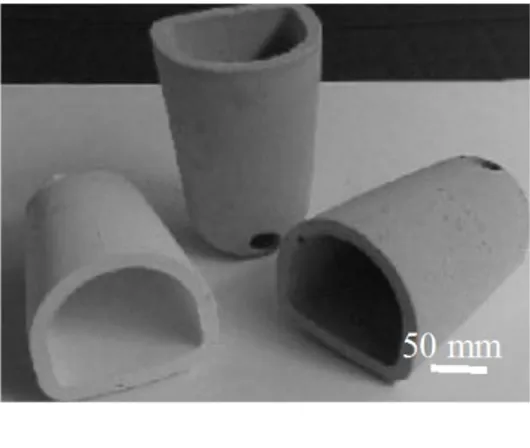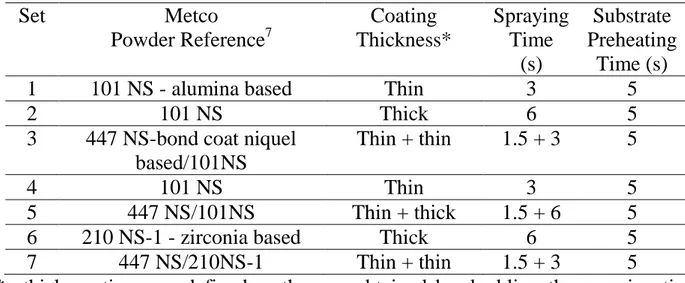COATED FLAME SPRAYED CERAMIC COMPONENTS
F. Jorge LINO, Teresa M. DUARTE and Ricardo S. MAIA
FEUP – Faculdade de Engenharia da Universidade do Porto, DEMEGI – Departamento de Engenharia Mecânica e Gestão Industrial, Rua Dr. Roberto Frias, 4200-465 Porto, Portugal.
A rapid manufacturing process of ceramic components with shapes closed to the final ones is described. The process is based on a sol gel processing, low cost raw materials, and adequate sintering conditions. A significant improvement of the ceramic components chemical resistance to continuous contact with melted aluminium alloys is obtained when an alumina flame sprayed coating is deposited on their surface.
1. INTRODUCION
The foundry industry frequently needs ceramic parts with different geometries for contact with metallic alloys. These parts must have mechanical resistance, resistance to the erosive wear and chemical attack of the liquid metal, high refractoriness and thermal insulation. Considering these factors, the authors have been working in a technology, which allows rapid manufacturing of ceramic prototypes and pre series, with different shapes, controlled levels of porosity and adequate resistance for contact with liquid metals. Although the existence of porosity in the parts is responsible for a significant decrease in the mechanical properties, it gives them the possibility to exhibit thermal insulation and low dimensional variation, which makes this process extremely interesting for applications related with the foundry industry1-4.
Starting from the model (can be obtained by rapid prototyping5, 6) of the ceramic part to be obtained, a mould is manufactured. A ceramic slurry that suffers a sol-gel reaction is cast into the mould. After a short period of time, the ceramic part obtained is demoulded and burned (stabilized)2, 4. Figure 1 shows some ceramic crucibles, with different compositions, for melting metallic alloys.
FIGURE 1 Ceramic crucibles.
The green ceramic parts are then sintered to increase the mechanical strength. Although the ceramic particles have been frequently employed in ceramic mouldings for metallic moulds production, there is still no guarantee that the components produced will have adequate continuous resistance to chemical and erosive wear of the liquid metals. In order to further improve this resistance, flame sprayed ceramic coatings can be applied on the components surface.
2. EXPERIMENTAL WORK
Different powders, a binder and a catalyst compose the ceramic slurry. The raw materials employed were molochite, zircon and rutile. Different particle sizes and shapes were used to improve the packing degree. The binder was ethyl silicate and the catalyst ammonium hydroxide (NH4OH) at 2.5%.
The experimental work was conducted using different types of specimens (3-point bend and adhesion test specimens). The main steps for the specimen manufacturing are indicated in reference 4).
The samples were heated at 1000ºC/h to the sintering temperatures of 1050ºC, 1200ºC, 1350ºC and 1500ºC, with dwell times of 2, 4 and 6 hours for each temperature. After sintering, the specimens were measured and tested for 3-point bend strength determination.
To characterize the tensile adhesion between the coatings and the substrate, specimens were coated by flame spray using three different powders, which were selected in accordance with technical information7 and considering the coating resistance to molten aluminium alloys2, 8. Table 1 presents the spray characteristics of the powders selected. Sets 1 and 4 were sprayed under the same conditions, however, set 1 was subjected to a subsequent heat treatment8.
TABLE 1 Spray characteristics. Set Metco Powder Reference7 Coating Thickness* Spraying Time (s) Substrate Preheating Time (s)
1 101 NS - alumina based Thin 3 5
2 101 NS Thick 6 5
3 447 NS-bond coat niquel
based/101NS
Thin + thin 1.5 + 3 5
4 101 NS Thin 3 5
5 447 NS/101NS Thin + thick 1.5 + 6 5
6 210 NS-1 - zirconia based Thick 6 5
7 447 NS/210NS-1 Thin + thin 1.5 + 3 5
*a thick coating was defined as the one obtained by doubling the spraying time used for a thin coating, which is 3 s. It should also be mentioned that due to the high deposition rate of the 447 powder, this powder was only sprayed for 1.5 s.
Coated specimens were glued with a cyanoacrylate adhesive to a polished non-coated aluminium specimen inside a sleeve and tensile tested, at room temperature. One set with just metallic specimens was also prepared and tested in order to determine the glue strength.
For the reaction tests with molten aluminium alloys, a special furnace was designed and manufactured. The objective of this test is the evaluation of the erosive and reaction behaviour of the ceramic component in a real environment and in a continuous situation9. The coated and uncoated ceramic parts were attached to a spinning shaft and submerged into a molten aluminium bath (AFNOR AS7G). Test parameters are shown in Table 2. After the tests, all the components were analysed using optical and electronic microscopy.
TABLE 2 Test parameters. Component Temp. (ºC) Time (Hours) Rotating
speed (rpm) Coating Comments
1 800 168 26 Set 5 447NS + NS101 - 2 800 168 26 Without coating - 3 800 168 26 Set 2 - NS101 Presented manufacturing defects 4 800 168 26 Set 2 - NS101 -
3. RESULTS AND DISCUSSION
The 3-point bend test results can be observed on fig. 2. As one can easily see, a sintering temperature of 1500ºC allows ceramic parts production with the highest strengths (around 20MPa). With this sintering temperature and a 2 hours stage, porosity levels around 32% can be obtained. It should be pointed out that using this
temperature has an inconvenient, since the shrinkage is more elevated. The dimensional characterization revealed values of volumetric changes around 6%. Taking into account that the improvement in mechanical strength is extremely elevated, one should consider the ceramic components production with this shrinkage3, 4. 0 3 6 9 12 15 18 21 24 0 2 4 6
Sintering Time (hours)
B ending S tr ength ( M P a) 1500°C 1350°C 1200°C 1050°C FIGURE 2
3-point bend resistance with the time and sintering temperature.
The results obtained with the tensile tests performed on the coated ceramic specimens are indicated in Fig. 3. As one can see, the highest tensile bond strengths, around 3 MPa, are obtained with alumina thick coatings, with or without bond coat (sets 2 and 5). The heat treatment (set 1) increased the bond strength by 2 MPa, relatively to the as-sprayed thin coating of the same material (set 4). Comparing sets 1 and 2, which have similar bond strengths for thin and thick alumina coatings, respectively, its seems that there is no reason to choose to heat treat as was done for set 1. In fact, heat treatment increases the production time and
the cost without significant improvement of the bond strength. Considering this, in a first step, only sets 2 and 5 were selected for the reaction tests.
Components without coatings showed aluminum penetration with the aluminum layer stuck to the ceramic substrate. Figure 4 shows aluminium penetration on the ceramic substrate of one uncoated sample (specimen 2). The darker regions on the aluminium side represent primary silicon crystals and eutectic silicon. 0 2 4 6 8 10 12 14 1 - With Heat Treatment 2 3 4 5 7 Test to the adhesive
Set
B
ond
S
tr
e
ngt
h (
M
P
a
)
FIGURE 3Bond strength for the different sets (ten specimens each) tested.
Specimen 3 presented manufacturing defects, which promoted aluminium infiltration in the ceramic and the rapid destruction of the component.
In the coated components with thick alumina coatings (sample 4), the aluminum layer detaches very easily from the shaft.Figure 5 presents the specimen after the reactivity test, showing how easy the aluminium detaches from the coating.
In principle, any advantage was found in using a bond coat (sample 1) on these types of ceramics. This coating is useful in coating metals with ceramics, in order
to overcome the thermal expansion mismatch between the two groups of materials. In this case, where the two groups have similar thermal expansion coefficients, this is not relevant.
The results obtained demonstrate the benefit in coating the ceramic components for continuous or prolonged contact with aluminium alloys.
FIGURE 4
Optical micrograph showing the ceramic substrate (left) with aluminium (right) penetration (lighter regions on the ceramic).
FIGURE 5
Ceramic coated sample showing the aluminium layer detachment from the coating.
4. CONCLUSIONS
A manufacturing process involving low cost ceramic raw materials and low dimensional variations (maximum 6%) for rapid production of ceramic components with complicated geometries and good mechanical properties was presented.
Ceramic components with tailored resistance for contact with a liquid aluminium alloy were developed. These ceramics were produced by a sol-gel process and sintered at 1500ºC for 2 hours. In continuous contact with an AS7G (AFNOR) aluminium alloy, these ceramics degrade by liquid penetration, but, when coated with an alumina coating, they showed very good performance for short and long periods of time, with no aluminium penetration being observed. The coatings produced have around 3 MPa bond strength.
ACKOWLEDGMENT
The authors would like to acknowledge the financial support obtained through the programme PRAXIS XXI of Fundação para a Ciência e Tecnologia of the Portuguese Government, through the project PRAXIS/P/CTM/14145/98, “Study of Paintings, Coatings and Ceramic Components for Aluminium alloys Foundry”.
REFERENCES
1) T. P. DUARTE, F. J. LINO and R. J. NETO, Ceramic Materials for Casting Metallic Moulds, Struers Journal of Materialography, Structure 34 (1999) 9. 2) ASM, Casting, ASM Handbook Vol. 15 (ASM International, USA) (1998). 3) F. J. LINO, T. P. DUARTE and J. TEIXEIRA, Fabrico de Componentes
Cerâmicos com Resistência à Fractura Optimizada, 7as Jornadas de Fractura, UBI, Covilhã, Portugal, 16-18 Feb. 2000, 248.
4) T. P. DUARTE, F. J. LINO, A. BARBEDO and J. M. FERREIRA, Metallic Tools Obtained from Ceramic Moulding Using a Sol-Gel Process, CIMTEC 2002, 10th International Conferences on Modern Materials & Technologies, 10th International Ceramics Congress & 3rd Forum on New Materials, Florence, Italy, 14-19 July (2002).
5) D. T. Pham & S. S. Dimov, Rapid Manufacturing, The Technologies & Applications of Rapid Prototyping & Rapid Tooling, (Springer-Verlag London Limited, UK) (2001).
6) Fernando Jorge Lino Alves, Fernando Jorge Sousa Braga, Manuel São Simão, Rui Jorge de Lemos Neto, e Teresa Margarida Guerra Pereira Duarte, PROTOCLICK - Prototipagem Rápida”, (Protoclick, Porto, Portugal) (2001). (in portuguese).
7) Anon, Technical Bulletin – Flame Spray Equipment and Supplies, METCO 101 NS, METCO 447 NS, METCO 210 NS-1 (Metco Perkin Elmer, Welsbury, NY, USA) (1982).
8) F. J. LINO, T. P. DUARTE and R. MAIA, Coated Ceramic Components for Aluminum Industry, to be published in the Journal of Thermal Spray (2002). 9) M. FOULETIER and D. GOLD, Selective, Accelerated Test for Evaluation of
Refractory Lifetime in Contact With Aluminium Alloys, UNITECR’ 91, 2nd
Bienal Worldwide Conference on Refractories, (edited by German Refractories Association & Institut für Gesteinshüttenkunde, 2nded., Stahleisen, Germany) (1992).

